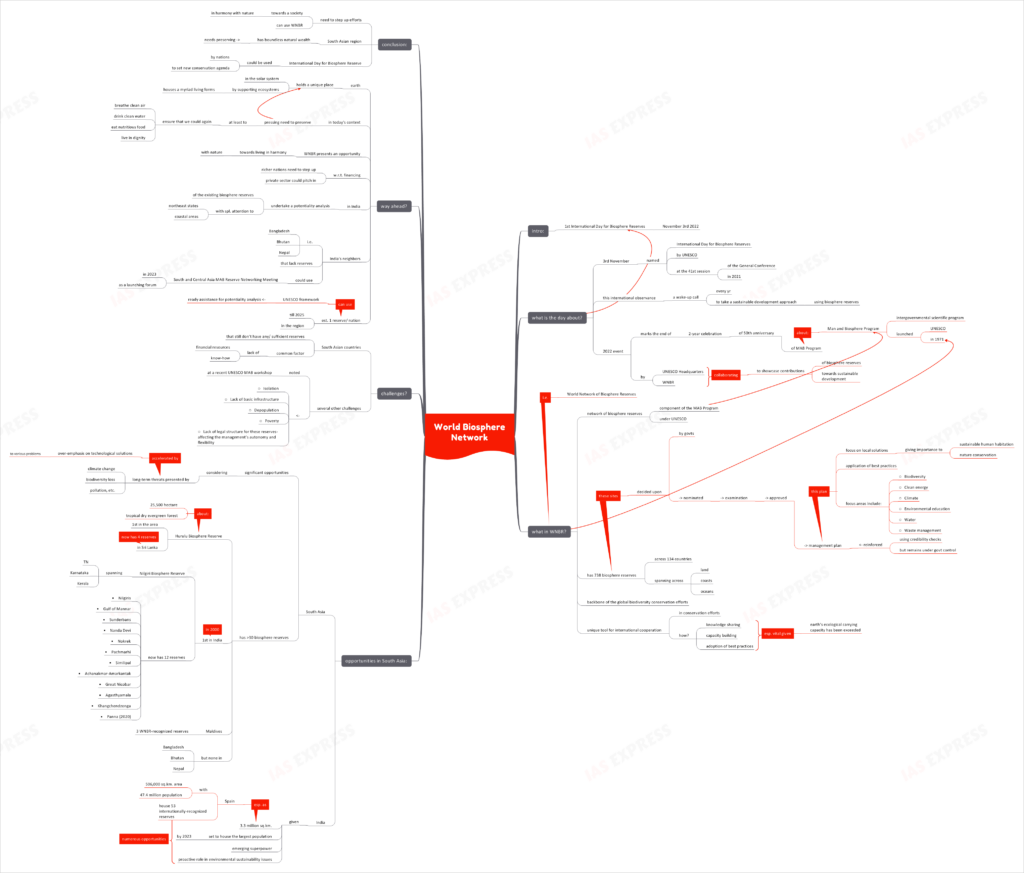World Biosphere Network- Opportunities and Challenges for South Asia

November 3rd 2022 is the first International Day for Biosphere Reserves. On this occasion, the South Asian region stands to gain much by tapping into the WNBR.

This topic of “World Biosphere Network- Opportunities and Challenges for South Asia” is important from the perspective of the UPSC IAS Examination, which falls under General Studies Portion.
What is The International Day for Biosphere Reserves?
- 3rd November was named as the International Day for Biosphere Reserves by UNESCO, at the 41st session of the General Conference in 2021.
- The day is to serve as a wake-up call, every year, reminding the nations to take a sustainable development approach, using biosphere reserves.
- The 2022 event marks the end of the 2-year celebration of the MAB program’s 50th anniversary.
- MAB or Man and Biosphere Program is an intergovernmental scientific program, launched by the UNESCO in 1971.
- The UNESCO Headquarters and the World Network of Biosphere Reserves are collaborating to mark this event by showcasing the biosphere reserves’ contribution towards sustainable development.
What is World Network of Biosphere Reserves?
- The WNBR or World Network of Biosphere Reserves is a network of biosphere reserves under the UNESCO. It is a component of the MAB Program.
- This network, formed in 1971, functions as the backbone of the global biodiversity conservation efforts.
- It now has 738 biosphere reserves across 134 countries.
- It is a unique tool for international cooperation in conservation efforts. It helps in knowledge sharing, capacity building and adoption of best practices. This is especially vital in a time when the earth’s ecological carrying capacity has been exceeded.
- The biosphere reserves, spanning across land, coasts and oceans, are decided by the governments. Following government nomination, these sites are examined. If approved, these reserves are managed according to a science-based plan.
- These plans focus on local solutions giving importance to both, sustainable human habitation and nature conservation. It calls for the application of best practices.
- Some of its focus areas include:
- Biodiversity
- Clean energy
- Climate
- Environmental education
- Water
- Waste management
- Note that these plans are reinforced using credibility checks, but remain under the respective government’s control.
What are the opportunities in South Asia?
- South Asia presents significant opportunities, considering the long-term threats presented by climate change, biodiversity loss, pollution, etc., accelerated by over-emphasis on technological solutions to the myriad problems facing the international community.
- There are more than 30 biosphere reserves in South Asia.
- The 1st reserve in the area was Hurulu Biosphere Reserve, a 25,500 hectare tropical dry evergreen forest in Sri Lanka. The country now has 4 such internationally-recognized reserves in total.
- In India, the Nilgiri Biosphere Reserve, spanning Tamil Nadu, Kerala and Karnataka, was the 1st to get the designation in 2000. India now has 12 such reserves.
- Nilgiris
- Gulf of Mannar
- Sunderbans
- Nanda Devi
- Nokrek
- Pachmarhi
- Similipal
- Achanakmar-Amarkantak
- Great Nicobar
- Agasthyamala
- Khangchendzonga
- Panna (2020)
- Our southern neighbour, Maldives houses 3 WNBR-recognized reserves.
- However, there aren’t any WNBR reserves in the other neighbours’ territories- Bangladesh, Bhutan and Nepal.
- India, spanning 3.3 million sq.km., and set to house the largest population by 2023, is an emerging superpower looking at numerous opportunities. It is also noteworthy for its proactive role in environmental sustainability issues.
- If Spain, with a 506,000 sq.km. area and 47.4 million population, could house 53 internationally-recognized reserves, India has a great opportunity under the WNBR framework.
What are the challenges?
- In the South Asian countries that still don’t have any/ sufficient reserves, a common factor is lack of financial resources and know-how, even if there is political will.
- At a recent UNESCO MAB workshop, organized in May, several other challenges were identified in biosphere reserves:
- Isolation
- Lack of basic infrastructure
- Depopulation
- Poverty
- Lack of legal structure for these reserves- affecting the management’s autonomy and flexibility
What is the way ahead?
- The earth, by supporting ecosystems that houses a myriad living forms, holds a unique place in the solar system. In today’s context, there is a pressing need to preserve this uniqueness, at least to ensure that we could breathe clean air, drink clean water, eat nutritious food and live in dignity again.
- Here, the WNBR presents an opportunity for the nations to take efforts towards living in harmony with nature.
- With regards to financing this project, the richer nations need to step up their financial support for the Global South. The private sector could pitch in to accelerate the efforts.
- For India’s part, there is a need to undertake a potentiality analysis of the existing biosphere reserves outside the WNBR framework. Special attention must be accorded to the north-eastern states and the coastal areas.
- Though India’s neighbours, Bangladesh, Bhutan and Nepal currently lack such protective establishments, the South and Central Asia MAB Reserve Networking Meeting is set to take place in 2023. This could serve as a launching forum for the countries’ contributions to international conservation efforts.
- Efforts are required to establish at least 1 reserve per country in the region till 2025. The UNESCO framework provides ready assistance for potentiality analysis. The countries need to take the step to tap into this tool’s potential.
Conclusion:
It is high time for the world nations to step up their efforts towards creating a society that exists in harmony with nature. Towards this, the WNBRs is available as a potent tool. South Asian region has boundless natural wealth that need preserving. The regions’ governments could use this 1st International Day for Biosphere Reserve to set a new agenda for conservation.
Practice Question for Mains:
What is the World Network for Biodiversity Reserves? Comment on the opportunities in South Asia region under this project. (250 words)

